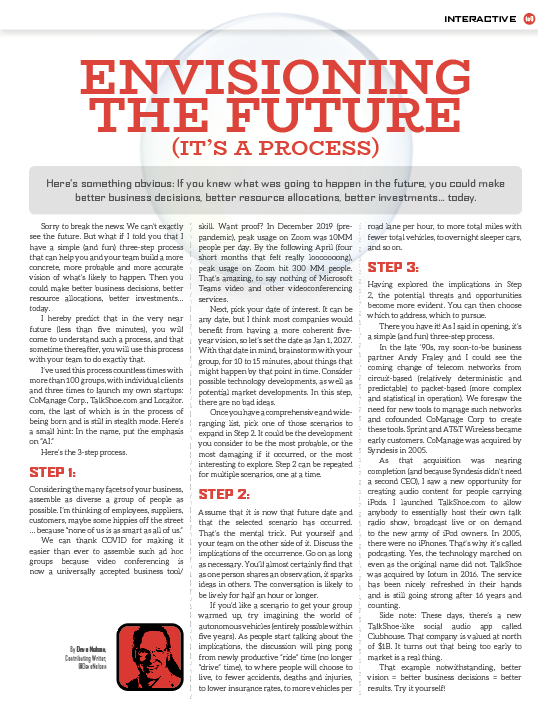Envisioning The Future
By Dave Nelsen
 Here’s something obvious: If you knew what was going to happen in the future, you could make better business decisions, better resource allocations, better investments… today.
Here’s something obvious: If you knew what was going to happen in the future, you could make better business decisions, better resource allocations, better investments… today.
Sorry to break the news: We can’t exactly see the future. But what if I told you that I have a simple (and fun) three-step process that can help you and your team build a more concrete, more probable and more accurate vision of what’s likely to happen. Then you could make better business decisions, better resource allocations, better investments… today.
I hereby predict that in the very near future (less than five minutes), you will come to understand such a process, and that sometime thereafter, you will use this process with your team to do exactly that.
I’ve used this process countless times with more than 100 groups, with individual clients and three times to launch my own startups: CoManage Corp., TalkShoe.com and Locaitor.com, the last of which is in the process of being born and is still in stealth mode. Here’s a small hint: In the name, put the emphasis on “AI.”
Here’s the 3-step process.
Step 1:
Considering the many facets of your business, assemble as diverse a group of people as possible. I’m thinking of employees, suppliers, customers, maybe some hippies off the street … because “none of us is as smart as all of us.”
We can thank COVID for making it easier than ever to assemble such ad hoc groups because video conferencing is now a universally accepted business tool/skill. Want proof? In December 2019 (pre-pandemic), peak usage on Zoom was 10MM people per day. By the following April (four short months that felt really looooooong), peak usage on Zoom hit 300 MM people. That’s amazing, to say nothing of Microsoft Teams video and other videoconferencing services.
Next, pick your date of interest. It can be any date, but I think most companies would benefit from having a more coherent five-year vision, so let’s set the date as Jan 1, 2027. With that date in mind, brainstorm with your group, for 10 to 15 minutes, about things that might happen by that point in time. Consider possible technology developments, as well as potential market developments. In this step, there are no bad ideas.
Once you have a comprehensive and wide-ranging list, pick one of those scenarios to expand in Step 2. It could be the development you consider to be the most probable, or the most damaging if it occurred, or the most interesting to explore. Step 2 can be repeated for multiple scenarios, one at a time.
Step 2:
Assume that it is now that future date and that the selected scenario has occurred. That’s the mental trick. Put yourself and your team on the other side of it. Discuss the implications of the occurrence. Go on as long as necessary. You’ll almost certainly find that as one person shares an observation, it sparks ideas in others. The conversation is likely to be lively for half an hour or longer.
If you’d like a scenario to get your group warmed up, try imagining the world of autonomous vehicles (entirely possible within five years). As people start talking about the implications, the discussion will ping pong from newly productive “ride” time (no longer “drive” time), to where people will choose to live, to fewer accidents, deaths and injuries, to lower insurance rates, to more vehicles per road lane per hour, to more total miles with fewer total vehicles, to overnight sleeper cars, and so on.
Step 3:
Having explored the implications in Step 2, the potential threats and opportunities become more evident. You can then choose which to address, which to pursue.
There you have it! As I said in opening, it’s a simple (and fun) three-step process.
In the late ’90s, my soon-to-be business partner Andy Fraley and I could see the coming change of telecom networks from circuit-based (relatively deterministic and predictable) to packet-based (more complex and statistical in operation). We foresaw the need for new tools to manage such networks and cofounded CoManage Corp to create these tools. Sprint and AT&T Wireless became early customers. CoManage was acquired by Syndesis in 2005.
As that acquisition was nearing completion (and because Syndesis didn’t need a second CEO), I saw a new opportunity for creating audio content for people carrying iPods. I launched TalkShoe.com to allow anybody to essentially host their own talk radio show, broadcast live or on demand to the new army of iPod owners. In 2005, there were no iPhones. That’s why it’s called podcasting. Yes, the technology marched on even as the original name did not. TalkShoe was acquired by Iotum in 2016. The service has been nicely refreshed in their hands and is still going strong after 16 years and counting.
Side note: These days, there’s a new TalkShoe-like social audio app called Clubhouse. That company is valued at north of $1B. It turns out that being too early to market is a real thing.
That example notwithstanding, better vision = better business decisions = better results. Try it yourself!